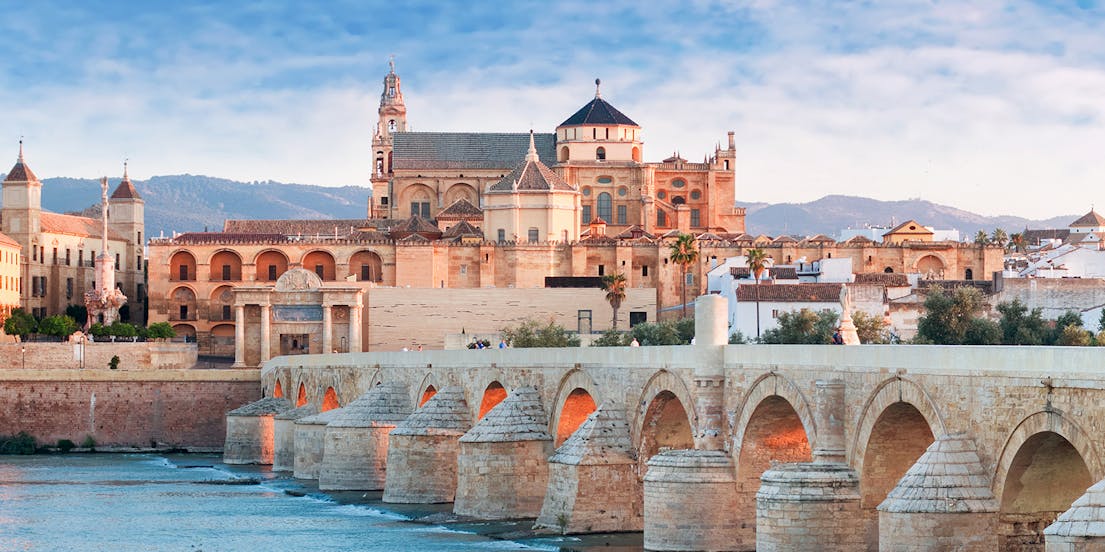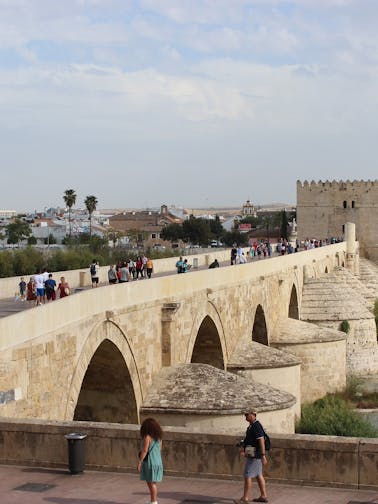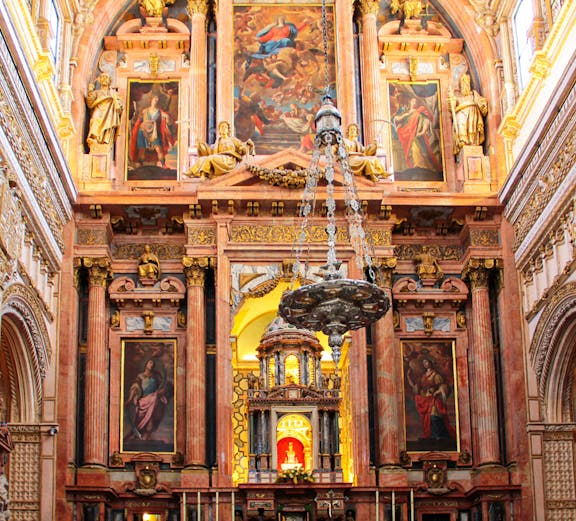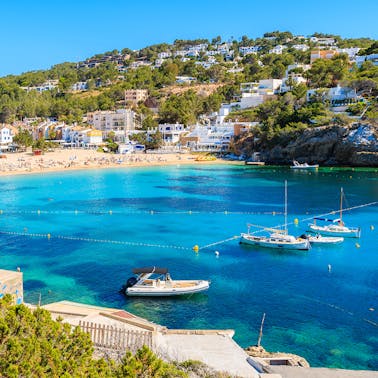Cordoba Mosque-Cathedral Tickets
Soak in the stunning architecture of the Cordoba Mosque-Cathedral, a historic structure that is the perfect amalgamation of both Islamic and Christian design elements. You can avail fast-track access, guided tours, and combo tours with popular experiences in the city with your Cordoba Mosque-Cathedral tickets.
14.4K+ travellers love this
See what they have to say
Visitor's guide
Must-see highlights & key info

-
Skip the ticket lines and step into one of Spain’s oldest and most iconic landmarks, the Cordoba Mosque-Cathedral.
-
Take in its striking fusion of Islamic arches, Christian chapels, and grand Baroque features all in one space.
-
Walk through the serene Orange Trees Courtyard and spend a quiet moment at the Capilla Mayor.
-
Your ticket also includes entry to the Route of the Fernandine Churches—another glimpse into Cordoba’s layered history.
-
Upgrade to a 1-hour guided tour or choose an audio guide in four languages, with headphones included for a smoother experience.
More details
-
Skip the ticket lines and step into one of Spain’s oldest and most iconic landmarks, the Cordoba Mosque-Cathedral.
-
Take in its striking fusion of Islamic arches, Christian chapels, and grand Baroque features all in one space.
-
Walk through the serene Orange Trees Courtyard and spend a quiet moment at the Capilla Mayor.
-
Your ticket also includes entry to the Route of the Fernandine Churches—another glimpse into Cordoba’s layered history.
-
Upgrade to a 1-hour guided tour or choose an audio guide in four languages, with headphones included for a smoother experience.
-
Skip the entry lines and save time with priority access to the Cordoba Mosque-Cathedral.
-
Explore this UNESCO-listed marvel with a multilingual expert in a 1-hour guided tour.
-
Learn how Islamic arches and Christian altars coexist in one stunning sacred site.
-
Use provided headphones in larger groups so you never miss a single detail.
-
Choose your preferred language—English, Spanish, Italian, or French—for a personalized experience.
More details
-
Skip the entry lines and save time with priority access to the Cordoba Mosque-Cathedral.
-
Explore this UNESCO-listed marvel with a multilingual expert in a 1-hour guided tour.
-
Learn how Islamic arches and Christian altars coexist in one stunning sacred site.
-
Use provided headphones in larger groups so you never miss a single detail.
-
Choose your preferred language—English, Spanish, Italian, or French—for a personalized experience.
10% off
-
Start with skip-the-line access to the iconic Mosque-Cathedral—home to 856 columns and its signature double arches.
-
Walk right past the queues at the Alcázar of the Christian Kings and explore its royal baths, mosaic-filled halls, and lush gardens.
-
Wander through the Jewish Quarter to see the 10th-century Synagogue, the statue of Maimonides, and the buzzing Arabic market.
-
Throughout the tour, an expert guide (available in French, Spanish, Italian, or English) will bring to life the city’s rich blend of Christian, Muslim, and Jewish influences.
More details
-
Start with skip-the-line access to the iconic Mosque-Cathedral—home to 856 columns and its signature double arches.
-
Walk right past the queues at the Alcázar of the Christian Kings and explore its royal baths, mosaic-filled halls, and lush gardens.
-
Wander through the Jewish Quarter to see the 10th-century Synagogue, the statue of Maimonides, and the buzzing Arabic market.
-
Throughout the tour, an expert guide (available in French, Spanish, Italian, or English) will bring to life the city’s rich blend of Christian, Muslim, and Jewish influences.
4% off
-
Roam around Cordoba on a 24-hour hop-on-hop-off bus tour with a multilingual audio guide. You also get guided walking tours of key areas.
-
Discover the city’s Moorish and Roman architecture over 22 stops on 2 distinct routes, including La Mezquita and Medina Azahara.
-
Explore the historic Cordoba Mosque-Cathedral, one of Spain's oldest structures showcasing a breathtaking fusion of Islamic art and Christian heritage.
-
Marvel at the architectural details, including the innovative double arches that added height and were groundbreaking in their era.
-
Fun fact: Inside the cathedral is Christopher Columbus's tomb, highlighting his ties to Spain and Cordoba's role in the Age of Exploration.
More details
-
Roam around Cordoba on a 24-hour hop-on-hop-off bus tour with a multilingual audio guide. You also get guided walking tours of key areas.
-
Discover the city’s Moorish and Roman architecture over 22 stops on 2 distinct routes, including La Mezquita and Medina Azahara.
-
Explore the historic Cordoba Mosque-Cathedral, one of Spain's oldest structures showcasing a breathtaking fusion of Islamic art and Christian heritage.
-
Marvel at the architectural details, including the innovative double arches that added height and were groundbreaking in their era.
-
Fun fact: Inside the cathedral is Christopher Columbus's tomb, highlighting his ties to Spain and Cordoba's role in the Age of Exploration.
5% off
-
Visit Medina Azahara, a 10th-century UNESCO-listed city near Córdoba.
-
Explore ruins like the House of Ya’far and the Grand Portico with a guide.
-
Skip the entry queues and enjoy in-depth stories with a local expert.
-
Tour includes the Medina Azahara Museum and onsite shuttle transport.
-
Choose English or Spanish guides, with optional round-trip transfers.
More details
-
Visit Medina Azahara, a 10th-century UNESCO-listed city near Córdoba.
-
Explore ruins like the House of Ya’far and the Grand Portico with a guide.
-
Skip the entry queues and enjoy in-depth stories with a local expert.
-
Tour includes the Medina Azahara Museum and onsite shuttle transport.
-
Choose English or Spanish guides, with optional round-trip transfers.
4% off
-
Skip the queues with convenient mobile tickets and enjoy a unique visit to the Cordoba Mosque-Cathedral at night.
-
Watch an immersive film tracing the Mosque's regal expansion under Almanzor to its cathedral transformation after the Reconquista.
-
The night show brings this historic site to life with soft lights, images, and sounds that accentuate the sky high arches and intricate carvings.
-
Discover hidden treasures like the beautiful chapels, orange courtyards, and ornate prayer halls, all taking on a mystical air under moonlight.
-
Fun fact: The cathedral features a stunning ‘forest’ of over 850 columns crafted from jasper, onyx, marble, and granite.
More details
-
Skip the queues with convenient mobile tickets and enjoy a unique visit to the Cordoba Mosque-Cathedral at night.
-
Watch an immersive film tracing the Mosque's regal expansion under Almanzor to its cathedral transformation after the Reconquista.
-
The night show brings this historic site to life with soft lights, images, and sounds that accentuate the sky high arches and intricate carvings.
-
Discover hidden treasures like the beautiful chapels, orange courtyards, and ornate prayer halls, all taking on a mystical air under moonlight.
-
Fun fact: The cathedral features a stunning ‘forest’ of over 850 columns crafted from jasper, onyx, marble, and granite.
-
Capture the essence of Córdoba on a walking tour and visit iconic spots like Mosque-Cathedral, a fusion of Islamic and Christian elements, with a guide.
-
Walk through the Jewish Quarter's narrow streets, admire the ancient Synagogue, and shop for handmade souvenirs at the Souk.
-
Skip the long queues at the Alcázar of the Catholic Kings, the former residence of the Castilian kings, and cap off the tour in Alcázar's extensive gardens.
-
Opt for an English, Spanish, or French-speaking guide as per your preference on this 4-hour tour.
-
Fun Fact: The Mosque-Cathedral houses Patio de los Naranjos or "Court of Oranges", filled with beautiful fountains and orange trees.
More details
-
Capture the essence of Córdoba on a walking tour and visit iconic spots like Mosque-Cathedral, a fusion of Islamic and Christian elements, with a guide.
-
Walk through the Jewish Quarter's narrow streets, admire the ancient Synagogue, and shop for handmade souvenirs at the Souk.
-
Skip the long queues at the Alcázar of the Catholic Kings, the former residence of the Castilian kings, and cap off the tour in Alcázar's extensive gardens.
-
Opt for an English, Spanish, or French-speaking guide as per your preference on this 4-hour tour.
-
Fun Fact: The Mosque-Cathedral houses Patio de los Naranjos or "Court of Oranges", filled with beautiful fountains and orange trees.
-
Explore Medina Azahara, an important monument in Cordoba, the Caliphate capital of Al-Andalus, during a 2-hour guided night tour.
-
Discover the palace layout, from grand residences to the fortified Alcázar, the core of Medina Azahara's administration and defense.
-
Walk through courtyards once frequented by kings, decorated with fountains, gardens, and pools, creating a peaceful atmosphere.
-
Choose the option with roundtrip transfers from Cordoba and forget the hassle of planning commutes!
-
Fun Facts: The name "Medina Azahara" translates to "the shining city," a nod to its opulent beauty and significance during the Caliphate.
More details
-
Explore Medina Azahara, an important monument in Cordoba, the Caliphate capital of Al-Andalus, during a 2-hour guided night tour.
-
Discover the palace layout, from grand residences to the fortified Alcázar, the core of Medina Azahara's administration and defense.
-
Walk through courtyards once frequented by kings, decorated with fountains, gardens, and pools, creating a peaceful atmosphere.
-
Choose the option with roundtrip transfers from Cordoba and forget the hassle of planning commutes!
-
Fun Facts: The name "Medina Azahara" translates to "the shining city," a nod to its opulent beauty and significance during the Caliphate.
-
Unravel Córdoba's historic treasures on a 2.5-hour guided tour in Spanish or French, encompassing the Mosque-Cathedral and Alcázar.
-
A fusion of Christian and Islamic design awaits at the Mosque-Cathedral. Spot the evolution in unique features like the minaret-turned-bell tower.
-
Walk amidst bicolor arches in the hall, the opulent main altar in the chapel, and a life-size sculpture of the Ascension of Jesus atop the choir throne!
-
Soak up the charm of the Alcázar's serene gardens and courtyards, and hear stories of Roman and Visigothic eras from a Spanish or French-speaking guide.
-
Fun Fact: The most lavish room in the Alcázar, the Ambassador’s Hall, was built to face Mecca under Al-Mutadim’s reign. Its orientation was changed during the Christian kings’ era.
More details
-
Unravel Córdoba's historic treasures on a 2.5-hour guided tour in Spanish or French, encompassing the Mosque-Cathedral and Alcázar.
-
A fusion of Christian and Islamic design awaits at the Mosque-Cathedral. Spot the evolution in unique features like the minaret-turned-bell tower.
-
Walk amidst bicolor arches in the hall, the opulent main altar in the chapel, and a life-size sculpture of the Ascension of Jesus atop the choir throne!
-
Soak up the charm of the Alcázar's serene gardens and courtyards, and hear stories of Roman and Visigothic eras from a Spanish or French-speaking guide.
-
Fun Fact: The most lavish room in the Alcázar, the Ambassador’s Hall, was built to face Mecca under Al-Mutadim’s reign. Its orientation was changed during the Christian kings’ era.
Pro tips to help you make a pick
Similar things to do in Cordoba
About Cordoba Mosque
The Cordoba Mosque, also known as the Mezquita Cathedral, is an architectural marvel that embodies the cultural synthesis of Islamic and Christian influences in Spain. Dating back to the 8th century, this iconic landmark boasts an array of horseshoe arches, intricate mosaics, and serene courtyards, reflecting centuries of artistic and religious evolution. Designated as a UNESCO World Heritage Site since 1984, Cordoba Mosque stands as a testament to the enduring legacy of Al-Andalus and its profound impact on Spain's cultural identity.
Why visit Cordoba Mosque?
Highlights
Plan your visit

Main entrance
The main entrance to Cordoba Mosque-Cathedral is located on Calle Torrijos, near the Patio de los Naranjos, in the historic center of Cordoba, Spain. At the entrance of Cordoba Mosque-Cathedral, visitors are greeted by a stunning façade adorned with intricate details. Stepping inside, a grand vestibule leads to the expansive interior, surrounded by towering columns and graceful arches.
It's important to note that the last entry into Cordoba Mosque-Cathedral is half an hour before closing time, and entry will be denied after this time.
Disabled toilets are available at Cordoba Mosque-Cathedral for visitors' convenience and accessibility.
Wheelchairs are available for visitors' use.
Service animals are permitted inside Cordoba Mosque-Cathedral for assistance purposes.
Travel guides and tips
Millions love heading out with us
Nearby cities to explore



































































































